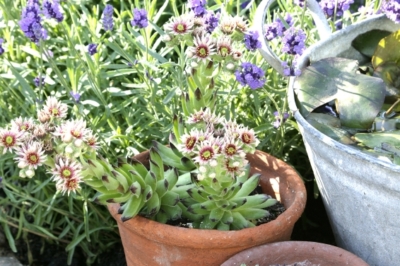A beautifully planted balcony gives a lot of pleasure, especially in the summer. Few things are more relaxing than sitting among all the wonderfully blooming and fragrant plants after work while enjoying a glass of wine.

Contents
The optimal location on the balcony
Flowering lavender reminds of the last vacation and relaxes body and mind, moreover, the intense scent keeps away pesky insects. Instead, the highly nectar-containing flowers provide rich food for bees and butterflies. In order for lavender to feel at home on your balcony, it should have sun all day long if possible – ergo, a southern or southwestern orientation is desirable. It should also be as sheltered as possible to protect the plants from strong weather conditions such as wind and precipitation.
Other suitable plants for a flowering balcony
Similar needs in terms of location as the lavender have flowering perennials such as
- Bearded flowers
- Broom
- Summer and autumn lilacs
- almond tree
- ornamental apple and cherry
- Rosemary, sage and thyme
- St. John’s wort
- Rock pear
- Wild roses (e.g. shrub roses)
- Substrate and planting container
The roots of lavender require quite a lot of space, so the planting container should be as wide and deep as possible. Low-growing lavender varieties can also be cultivated in a balcony box, although you should make sure that there is adequate water drainage.
Lavender can thrive in a balcony box or container, provided that you meet its specific growing requirements.
Here are some key factors to consider when growing lavender in a balcony box:
- Container Size: Use a sufficiently large and well-draining container. Lavender plants need space for their roots to grow and excellent drainage to prevent waterlogged soil. A container that is at least 12 inches deep and wide is a good starting point.
- Soil: Lavender prefers well-draining soil. Use a potting mix designed for container gardening or amend regular potting soil with sand or perlite to improve drainage.
- Sunlight: Lavender thrives in full sunlight. Ensure that your balcony box receives at least 6-8 hours of direct sunlight per day. Place it in the sunniest spot on your balcony.
- Watering: Lavender is drought-tolerant once established, so be careful not to overwater. Allow the soil to dry slightly between waterings. Water the plant thoroughly when the top inch of soil feels dry to the touch, and avoid wetting the foliage to prevent fungal issues.
- Pruning: Regularly trim your lavender to encourage bushier growth and prevent it from becoming too leggy. Pruning also helps maintain the plant’s shape and encourages more flowers.
- Fertilization: Lavender doesn’t require heavy feeding. You can fertilize sparingly with a balanced, slow-release fertilizer in the spring. Avoid over-fertilizing, as this can lead to excessive foliage growth at the expense of flowers.
- Protection from Harsh Weather: Lavender can be sensitive to harsh winter conditions. If you live in a region with cold winters, consider moving the container indoors or to a sheltered location to protect it from freezing temperatures and excessive moisture.
- Pest Control: Keep an eye out for common garden pests like aphids and scale insects, which can affect lavender. Inspect your plants regularly and use appropriate pest control methods if necessary.
Lavender can be a beautiful and fragrant addition to a balcony box, providing you with lovely blossoms and a pleasant aroma. Just be sure to meet its requirements for sunlight, well-drained soil, and proper maintenance to help it thrive.
Propagate lavender
Lavender can be propagated quite easily via cuttings. If you don’t have the space to overwinter the perennial plant properly, simply take cuttings and overwinter them. This saves a lot of space and usually works well on a windowsill in an unheated bedroom. For this purpose, cut off shoots about 10 to 15 centimeters long, still green, and put them in suitable lavender soil. Keep the substrate slightly moist, but not wet. The cuttings will take root after an average of four to six weeks. Besides, you can grow lavender plants yourself from commercially available seeds in the spring, instead of buying ready-made plantlets.
Winter lavender on the balcony?
Hardy lavender – which in principle only includes the many varieties of true lavender – can usually be overwintered on the balcony, provided good protection, of course. Cover the substrate with brushwood and wrap the pot with protective mats (e.g., coconut) or fleece to protect the delicate roots from frost. Non-hardy lavender – such as the particularly popular potted lavender – should not be left outside in winter, but should be left in cold storage conditions. Temperatures between 10 and 12 °C are ideal.
Tips & Tricks
Plant your lavender in containers made of natural materials such as clay, if possible. Plastic containers store too much water and do not allow it to evaporate, so a climate unfavorable to lavender can develop in them.

